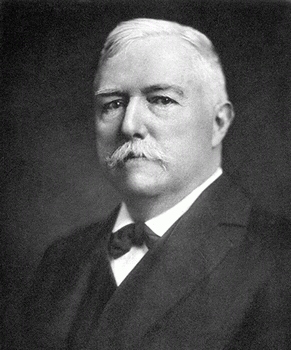
Edward Emerson Barnard (1857-1923)
On December 16, 1856, American astronomer Edward Emerson Barnard was born. Barnard is best known for his discovery of the high proper motion of Barnard’s Star in 1916, which is named in his honor. He also pioneered in celestial photography, specializing in wide-field photography.
Early Life
Edward Barnard was born in Nashville, Tennessee, the son of Reuben Barnard and Elizabeth Jane née Haywood. His father died before his birth, and the son grew up in poor circumstances. Barnard became a photographer’s assistant at the age of about nine. Later on, he began develop enthusiasm for astronomy. Around 1876, Barnard purchased a 130mm refractor telescope, and in 1881 he discovered his first comet, but unfortunately failed to announce his discovery. He found his second comet later the same year and a third in 1882. Edward continued his amateur astronomer activities and discovered a total of five comets. In the following years Barnard was so successful as a comet seeker that he was able to finance a house for himself and his young wife from the premiums that a sponsor had offered for (US-American) comet discoveries. A special case was the comet 1886 II, discovered by him in 1885, whose orbit changed from an elongated ellipse to a hyperbolic orbit due to orbit disturbances.
At a scientific conference he met Simon Newcomb, who motivated the knowledge-hungry young man to learn mathematics. At age 30, as Barnard’s reputation among amateur astronomers increased, money was raised collectively to give Edward a fellowship to Vanderbilt University. Barnard never graduated from the school, but he did receive the only honorary degree Vanderbilt has ever awarded. He joined the staff of the Lick Observatory in 1887, though he later clashed with its director, Edward S. Holden, over access to observing time on the larger instruments and other issues of research and management.
The Spokes of Saturn
During 1889, Edward Barnard observed the moon Iapetus pass behind Saturn’s rings and just as he watched Iapetus pass through the space between Saturn’s innermost rings and the planet itself, he saw a shadow pass over the moon. Even though not realizing it at that moment, Barnard had discovered proof of the “spokes” of Saturn, dark shadows running perpendicular to the circular paths of the rings. These spokes were doubted at first, but confirmed by the spacecraft Voyager 1.[8] About three years later Barnard made observations of a nova and was the first to notice the gaseous emissions, thus deducing that it was a stellar explosion. Barnard discovered a new moon of Jupiter since Galileo Galilei in 1609, which became the last satellite discovered by visual observation (rather than by examining photographic plates or other recorded images).[4]
Edward Barnard became professor of astronomy at the University of Chicago in 1895 and there he was also able to use the 1000 mm telescope at Yerkes Observatory. A lot of Barnard’s work at this time included taking photographs of the Milky Way. Along with Max Wolf, Barnard discovered that certain dark regions of the galaxy were actually clouds of gas and dust that obscured the more distant stars in the background.
![Barnard's star, photo: Steve Quirk [Public domain]](http://scihi.org/wp-content/uploads/2016/12/Barnardstar2006.jpg)
Barnard’s star, photo: Steve Quirk [Public domain]
Barnard’s Star
The faint Barnard’s Star is named for Edward Barnard after he discovered in 1916 that it had a very large proper motion, relative to other stars. This is the second nearest star system to the Sun, second only to the Alpha Centauri system. As a pioneering astrophotographer, Barnard was able to catalogue a series of dark nebulae, known as Barnard objects, giving them numerical designations akin to the Messier catalog. They begin with Barnard 1 and end with Barnard 370. He published his initial list with the 1919 paper in the Astrophysical Journal, “On the Dark Markings of the Sky with a Catalogue of 182 such Objects“.
Edward Barnard died in 1923. Many examples from his exceptional collection of astronomical photographs were published in 1927 as A Photographic Atlas of Selected Regions of the Milky Way, having been finished by Edwin B. Frost, then director of Yerkes Observatory, and Mary R. Calvert.
Pete Coffey, Seeing the back of your eye using Hubble Telescope technology!, [7]
References and Further Reading:
- [1] Edward Barnard Biographical
- [2] Edward Barnaed – Bruce Medalist
- [3] Edward Barnard at Harvard
- [4] Galileo Galilei and his Telescope, SciHi Blog
- [5] Edward Barnard at Wikidata
- [6] Edward Emerson Barnard’s Photographic Atlas of Selected Regions of the Milky Way
- [7] Pete Coffey, Seeing the back of your eye using Hubble Telescope technology!, 2013, The Royal Institution @ youtube
- [8] To Boldly Go Where No Man Has Gone Before – Voyager 2, SciHi Blog
- [9] Carey, Bill (October 29, 2001). “Astronomer Barnard was among Vanderbilt’s first academic superstars”. The Vanderbilt Register.
- [10] Sheehan, William (1995). The Immortal Fire Within: The Life and Work of Edward Emerson Barnard. Cambridge: Cambridge University Press.
- [11] Timeline for Edward Barnard, via Wikidata






Pingback: Whewell’s Gazette: Year 03, Vol. #18 | Whewell's Ghost